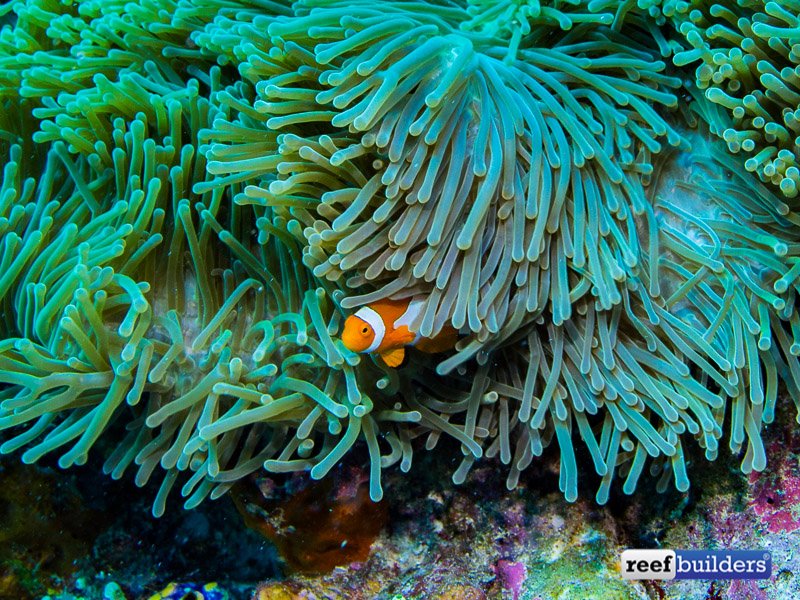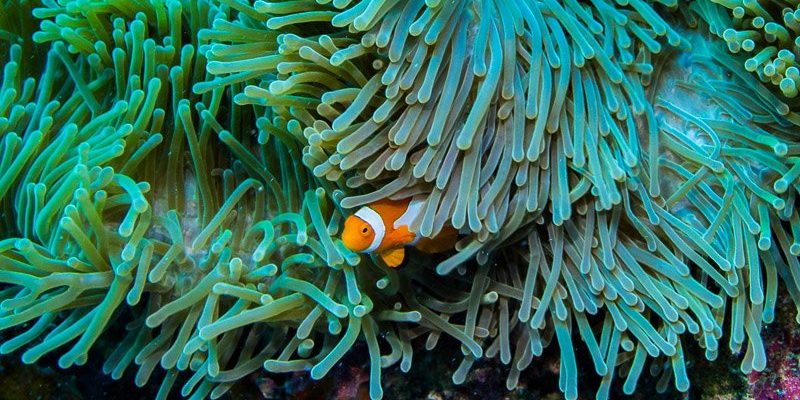
When you think of vibrant colors in the ocean, clownfish probably come to mind. They’re the little orange fish with the white stripes that seem to pop against the blue background of coral reefs. But there’s so much more to these fascinating creatures than their stunning looks. Clownfish are not just pretty faces; they have behaviors and adaptations that make them unique in the underwater world.
These fish are often associated with the sea anemones they call home. Just as a knight finds refuge in a castle, clownfish seek safety among the stinging tentacles of anemones. But don’t worry, they have a special relationship with these plants that protects them from predators. Get ready to dive deeper into the lives of clownfish, from their habitats and diets to their interesting behavior and reproduction!
What Are Clownfish?
Clownfish belong to the family Pomacentridae, which is a group of marine fishes that includes the famous anemonefish. These fish are easily recognizable due to their bright orange bodies and white bands edged in black. Typically, they grow to be about 4 to 5 inches long, although some species can be a bit larger.
There are about 30 different species of clownfish, with the Amphiprion ocellaris and Amphiprion percula being the most well-known. These little fish are native to the warm waters of the Pacific and Indian Oceans, particularly thriving in coral reefs where their vibrant colors really shine.
One of the most remarkable things about clownfish is their mutualistic relationship with sea anemones. These anemones provide a safe haven for clownfish, while the clownfish help the anemones by keeping them clean and providing nutrients through their waste. It’s a partnership where both parties benefit!
Habitat and Distribution
Clownfish primarily inhabit the warm waters of the tropical and subtropical coral reefs across the Pacific and Indian Oceans. They thrive in shallow lagoons and coastal reefs, where their bright colors can be seen darting in and out of sea anemone. But here’s the catch: not all anemones are suitable for clownfish. They prefer specific types, like the Heteractis magnifica or Entacmaea quadricolor.
Interestingly, clownfish are limited to certain areas within these waters. They typically live in groups, which provide them with added protection against predators. This social behavior is vital, as it helps them navigate their environment more effectively. You might notice a dominant male and female in a group, with the rest being smaller males. This social structure is fascinating and helps maintain their population stability.
Climate change is becoming a concern for clownfish as well. Rising ocean temperatures and acidification can damage their coral reef habitats. This not only affects clownfish but also a myriad of marine species that rely on healthy reefs for survival. Protecting their environment is crucial for their future.
Feeding and Diet
Clownfish are omnivores, which means they eat both plants and animals. Their diet in the wild typically consists of algae, zooplankton, small crustaceans, and even leftover food from the sea anemones they inhabit. It’s quite a varied menu! This diet is like a buffet that allows them to adapt to the available food sources around them.
In an aquarium setting, clownfish often eat commercial fish pellets, frozen or freeze-dried foods, and live foods. They’re not very picky, but they need a balanced diet to stay healthy. Ensuring they have the right nutrition is essential, just like how we need a balanced diet to thrive.
What’s interesting is that clownfish have a role in keeping their anemone homes clean. They often nibble on the algae and debris that might accumulate around their anemones, helping maintain a healthy living space. This cleaning behavior is one of the many ways these fish contribute to their ecosystem.
Behavior and Social Structure
Clownfish exhibit some fascinating behaviors that make them stand out. One of the most notable aspects of their social structure is the dominance hierarchy within their groups. The largest female will lead the group, usually being the only breeding female. The next largest, typically male, will be the breeding male. The rest of the group consists of smaller males that help protect the territory.
You might be wondering how they communicate. Clownfish use a mix of body language and vocalizations to express themselves. They can make various sounds, including popping and clicking, especially during mating rituals or when they feel threatened. It’s like having a small, underwater symphony right in the anemone!
Another interesting behavior is their nesting process. During spawning, the female will lay eggs on a flat surface near their anemone, often on the rocks or sand. The male will then fertilize the eggs and guard them diligently, keeping them free from predators and ensuring they have the best chance to hatch. This protective instinct showcases their commitment to the next generation.
Clownfish and Sea Anemones
The relationship between clownfish and sea anemones is a classic example of mutualism. Clownfish gain protection from predators by living among the stinging tentacles of anemones, while the anemones benefit from the nutrients left by the clownfish. It’s a win-win situation! But how do they manage to coexist without harm?
Clownfish have a special mucus coating on their skin that protects them from the anemone’s stinging cells, called nematocysts. Before they venture into an anemone, they build up this protective layer, allowing them to swim freely among the tentacles. This adaptation is crucial for their survival and is an excellent example of evolution at work.
Moreover, the clownfish’s activity actually benefits the anemone as well. By keeping the anemone clean and healthy, they ensure it can keep growing and thriving. The relationship is so strong that clownfish will even aggressively defend their anemones from potential threats, showcasing their loyalty and protective nature.
Reproduction and Lifespan
Clownfish are known for their interesting reproductive behaviors. They are monogamous, meaning a pair will mate for life. The breeding season usually occurs when water temperatures rise, prompting males and females to clean their chosen nesting site, often near their anemone. The female will lay a clutch of eggs, ranging from 100 to 1,500, depending on species, which the male will then fertilize.
Once the eggs are laid, the male takes on the role of protector. He guards the eggs against potential threats while aerating them by fanning them with his fins. The eggs hatch within 6 to 10 days, depending on water temperature, and the tiny clownfish larvae swim away, drifting in the open ocean until they settle down and find their own anemone host. It’s a tough journey ahead, but the survival of the fittest reigns supreme!
As for their lifespan, clownfish typically live for about 6 to 10 years in the wild. However, in captivity, with proper care and a suitable environment, they can live up to 20 years! This longevity is often a result of the absence of predators and the stable conditions provided in aquariums.
Interesting Facts About Clownfish
| Scientific Name: | Amphiprioninae |
| Size: | 4 to 5 inches |
| Habitat: | Coral reefs, lagoons |
| Diet: | Omnivorous (algae, zooplankton) |
| Lifespan: | 6 to 10 years in the wild, up to 20 years in captivity |
| Social Structure: | Hierarchical group with a dominant breeding pair |
Conservation and Threats
While clownfish are beloved for their colorful appearance, they face several threats in the wild. Habitat destruction, primarily due to coral reef degradation, poses a significant risk to their populations. Climate change, overfishing, and pollution also contribute to the decline of their natural habitats. It’s a tough world out there for these little fish!
Fortunately, clownfish are often bred in captivity for the aquarium trade, which helps reduce their demand from the wild. Maintaining healthy populations through responsible breeding can be a step towards ensuring their survival. Aquarists and conservationists are doing their part to raise awareness about the importance of protecting and preserving clownfish habitats.
Supporting marine conservation efforts and participating in local clean-up initiatives can also help protect their delicate ecosystems. After all, a healthy ocean is beneficial not just for clownfish but for countless marine species and our planet as a whole.
FAQ
Are clownfish really as friendly as they seem?
Clownfish are known for their vibrant colors and unique personalities. In the wild, they can be quite territorial, especially when defending their anemones. While they might appear friendly, they can be aggressive towards other fish that venture too close, especially if they feel threatened. In aquariums, however, they can show more docile behavior, particularly if raised in a peaceful environment.
Can clownfish survive without anemones?
Yes, clownfish can survive without anemones, but they thrive with them. Anemones provide safety from predators, while clownfish help keep the anemones healthy. Without their anemone hosts, clownfish are more vulnerable to attacks and may have a harder time finding food due to less shelter and increased competition.
What do clownfish do when they are scared?
When clownfish feel threatened, they will typically retreat quickly back into their anemone for safety. The tentacles of the anemone provide a protective barrier against predators. In some cases, they might also display threatening behaviors, such as flicking their fins or chirping sounds to warn off potential threats.
How do clownfish find their anemones?
Clownfish larvae are born in open water and drift away from their nests for several days. They use their sense of smell to locate the right anemone species. Once they find a suitable home, they’ll begin to develop a protective layer of mucus that allows them to coexist with the anemone without being harmed.
Do clownfish have predators?
Yes, clownfish do have natural predators, including larger fish such as lionfish, groupers, and eels. However, their close relationship with anemones provides them with a level of protection, as many potential predators are deterred by the stinging tentacles of the anemone.
How can I keep clownfish in my aquarium?
Keeping clownfish in an aquarium can be a rewarding experience. Ensure you have a properly sized tank with plenty of hiding spots, such as rock formations and plants. It’s also essential to include an anemone that is compatible with clownfish. Regular maintenance, including water quality checks and a balanced diet, will help keep your clownfish healthy and happy.
What is the best diet for clownfish?
The best diet for clownfish includes high-quality flakes, pellets, and frozen food like brine shrimp or mysis shrimp. Provide a varied diet that also includes some vegetable matter, like spirulina or algae. This variety helps ensure they get the nutrients they need to thrive.

